PONTUS ALV, THE LAST INTERVIEW
Posted on Friday, August 21, 2015 by Paul
The “The Last Interview” headline might be a bit misleading. But don’t blame me... I stole it from Transworld. They did an interview with Pontus in their February ‘15 issue where he said pretty directly “this is my last interview.” I figure that since this is coming out long after that one, well there you go. But to be fair to all parties, Pontus and I talked before he spoke to TWS; but due to various shenanigans, the printed version of our chat never came out anywhere. So, to sum up, while this is in fact the second last interview Pontus might ever give, I’m going with it being his last to sell more copies or whatever. Anyway, hopefully you learn something new from it. And sorry for lagging so hard on this Pontus.
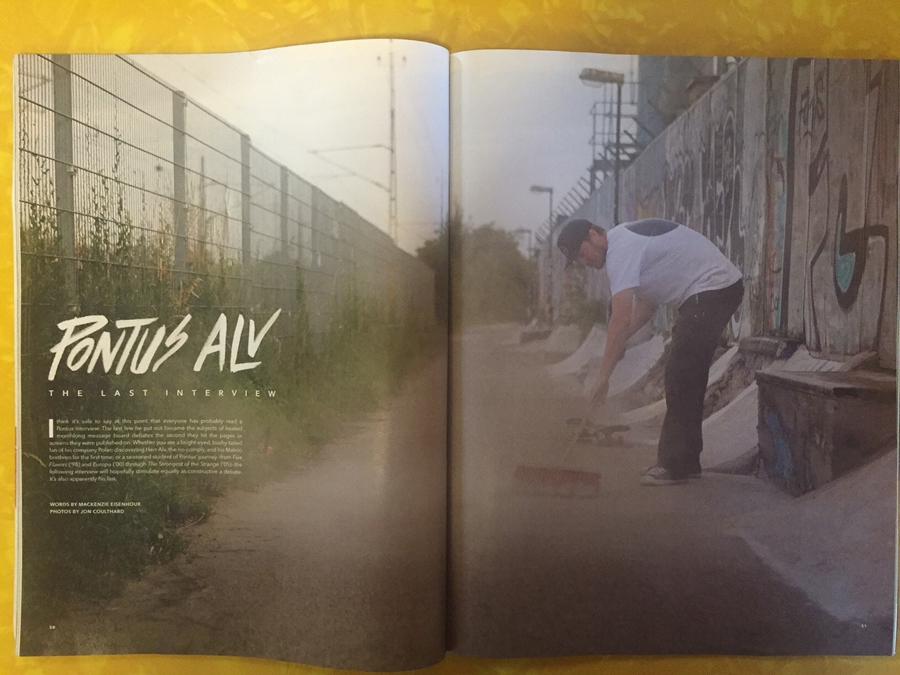
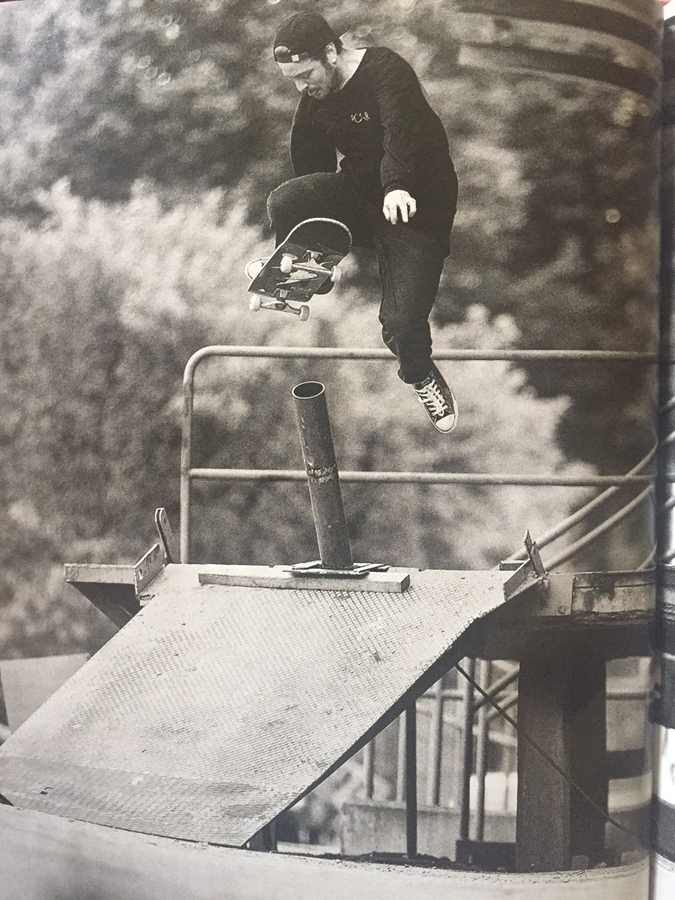
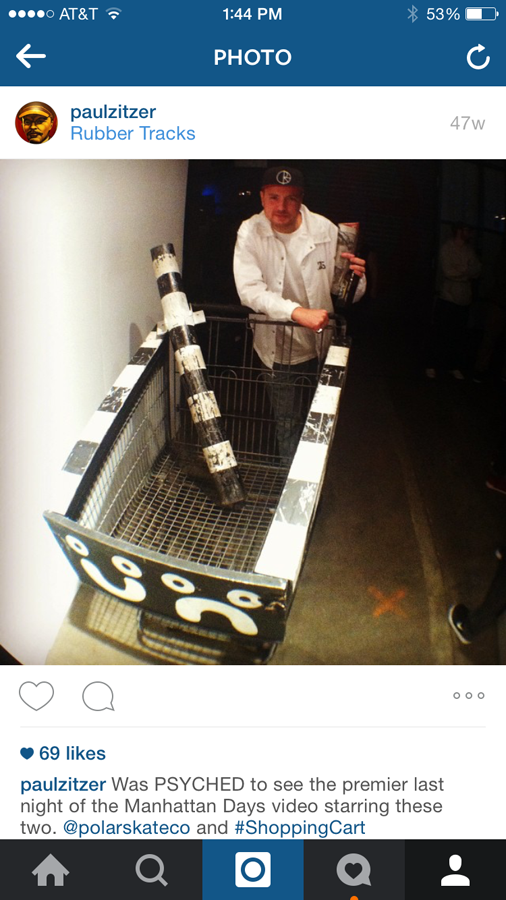
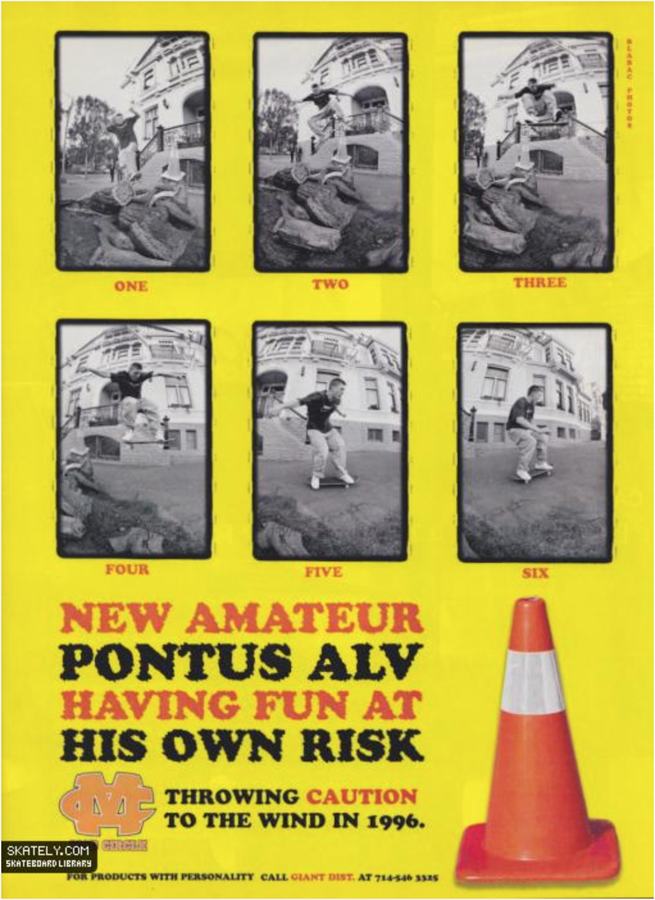
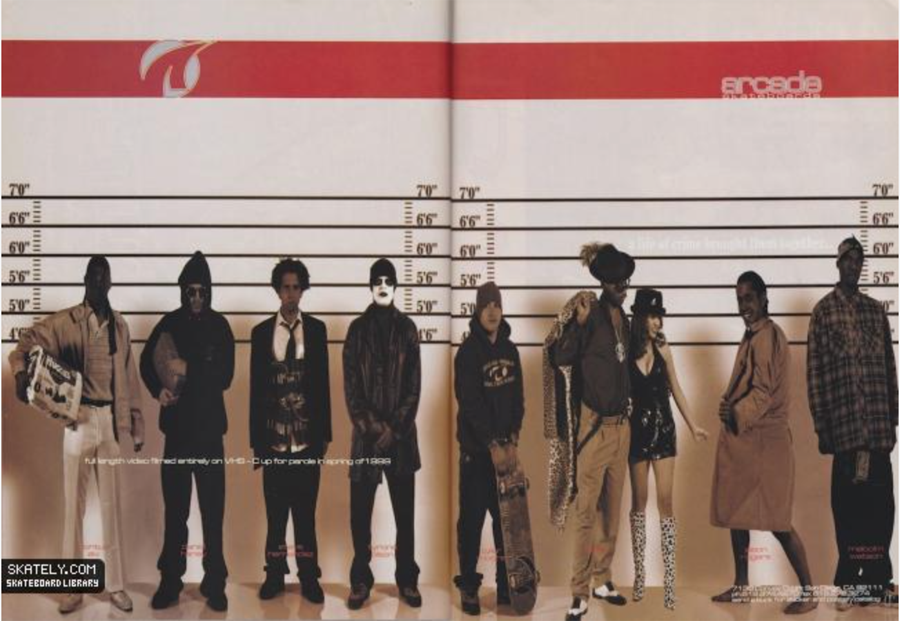
See, I don’t make all of this stuff up. More accurately, the title for the TWS Pontus interview should've been called “THE PENULTIMATE INTERVIEW.”
Where have you been skateboarding lately?
When I’m at home my daily routine is pretty simple. I live 10 minutes from my office, so I come here in the morning around 10, and lately I’ve been building a lot at TBS, you know that dream bank spot? And that’s like pretty much two minutes from my house the other way. I have this little triangle, working, and then when I’m fed up with work I go down there and build, and that’s what I’ve been doing the last 10 days, building and skating. I’ve been building four or five new pieces down there. I’m going to film my video part at this spot so I want to get some new shit going there.
Do new spots pop up much in Malmo?
It’s happening all the time since we got the bridge in 2000 or 2001 I think, the bridge to Copenhagen. Before that the city was kind of like a dead industrial city, and then I’d say in the last 15 years they’ve been redoing the entire city. Redoing neighborhoods, schools, offices, so now it’s really pumping and happening, and every year there’s like a new area of the city that they open up, you know, shopping malls, hotel centers, so yeah there’s definitely new stuff coming all the time.
This photo by Jon Coulthard which appeared in TWS should have been used for my Pontus interview but I blew it. So I’m trying to right past wrongs by using it here.
If you’re going to travel anywhere, what’s your favorite skate destination?
New York pretty much. It’s got everything. New York or Paris. I like the cities. I like the Paris vibe, really smooth streets everywhere, and of course the nightlife, food, restaurants, the quality of life is really good in Paris, and same in New York. I don’t like going places just for skating, I like going there for being inspired, seeing everything from art, fashion, people, just kind of picking up things and meeting interesting characters, and I believe that happens a lot in Paris and New York. So yeah those are the two cities I like traveling to for skating and enjoying life.
I shot this for Insta in NYC at the premier of Manhattan Days. I didn’t have the heart to tell him it would be 47 weeks before the interview ever came out.
Let’s talk a little bit about history. You were pro for Mad Circle obviously in the 90’s…
I was never pro for Mad Circle.
Oh! You were never pro for Mad Circle, you rode for them in the '90s?
I was amateur. The company shut down before I reached…I was in school, so I was supposed to be out of school and move to SF and turn pro, but then they shut it down.

Photo courtesy of Skately.com
Overall was that a positive experience for you though, do you look back on those times like they were The Good Old Days?
Yes and no. The time I came out was ’95. So from ’95 to maybe ’97, the two first years were really good, because Justin [Girard, Mad Circle founder] was still really into skateboarding and he was still skating and we’d go skating, then, and I kind of understand it now because I’m in the same position running my own company, just like work, deadlines, growing, and the company was really successful so it was a shitload of work for him, so he just kind of got bitter, you know, that he got ripped off from Giant, and then the last year or so was not too good because he was pretty much hating on skaters, skateboarding, he was pretty burnt out from everything, that’s why he kind of left and shut it down and disappeared pretty much.
Who did you end up turning pro for then?
Back then in the ‘90s it was pretty much unheard of having guys from Europe, and you know, I was talking to guys at Foundation, and Stereo, Deluxe, and everyone was like, “Yeah, we don’t know, we’ll send you a box” or whatever, and I was in Sweden, trying to make it happen from Sweden, and back then I was 16, 17 and it was not really easy making a long distance call from Sweden, like, “Yo, Brad Staba what’s up man? Could you maybe hook me up with Foundation, or talk to Josh Beagle?” And everyone just said, “Yeah we can do it.” And then nothing happened. And then Jason Rogers from H-Street and all that, he was doing Arcade, and he was pretty much straightforward, “I’ll give you a plane ticket to come out here, I’ll give you a paycheck, and I’ll give you a board straight up.” And I was just like, “All right, that’s a sweet deal. So I just kind of jumped on the train. I thought maybe we could start working on some good videos, graphics, and whatever, but in the end, with Tyrone Olson and the San Diego vibe and all that, it wasn’t really my cup of tea, so I kind of just left. Being in SF was really great, you know, it’s a very European city, and then coming down to Southern California, where you have to have a drivers license, you have to have a car, and the skating atmosphere is so different, and I wasn’t really feeling it at all so I just kind of bailed out.
So you went back to Sweden and then what?
I came back to Europe. I was 19 or 20 maybe. It was 2000 I’d say. But before I left California I was sitting around getting fat. And I was really depressed because I didn’t have a car, and Jason was in the office Monday through Friday so I was just at home playing video games in his house and I was like, “This sucks. I gotta get out of here.” I pretty much just took a cab to the airport and left California. In my head I was like, “That’s my career. It’s over.” Because back then it wasn’t like heard of that you go back to Europe and have a career, it was only California. So I came back and didn’t have any sponsors or anything. And I also was really burnt out on skating, because being in California when you ride for Mad Circle, everybody wants to be your friend and they kiss your ass, and then when you don’t ride for the cool company with the cool guys in SF, and you ride for Arcade, now I understand it but back then I was a kid and I was like, “Why doesn’t anyone want to be my friend?” You know? So yeah, I was just burnt out on the whole industry.

Photo courtesy of Skately.com
But anyway yeah, I got back [to Sweden], no sponsors really and I was really over skating. I was thinking, “I’ll go back to school.” But I came home and started skating with my friends and started enjoying it again. And that’s when I called Jeremy [Daclin] at Cliché because I’d met him a few years before when I came to his city, Lyon [France], we skated, and I saw his office back then in the mid ‘90s, and I thought it was really creative and cool, and I thought his whole vibe was really sick and he was a really amazing skater at the time, he did amazing stuff, so I really like the idea that he had going, and I was like, let me ride for this European company and we’ll try to build it up and do something. And yeah, I got a board on it, and we started working. That was the same time with French Fred and eS Menikmati, and we did Cliché Europa, back then Europe was totally untouched land, we went to Barcelona and it was all these spots, and Lyon, all these cities, nobody came there. And so we did that video and it came out, and then eS came out with their video and it was like, “Damn, Europe is the shit.” And then everything just went off from there.
Did you ever find it surprising how much love you got from the Message Boards? You’re like a hero on Slap.
Am I? (Laughing). I mean I do occasionally check it out, or I hear people say, “Did you read that Slap thing?” But I used to have a login but I lost my password so I can’t really answer. Sometimes I want to reply to people but there are so many people you have to reply to. My whole gig is that I’ve been in America and seen all that, and I was in Europe with Cliché and saw all that, and I’ve lived different lives and had different types of gigs going, and I don’t know I just kind of left everything, like I left Cliché when they got investors and they got French Fred on board and shit got really serious with that second video, Bon Appetit, it took away all the fun that it was in the beginning. And I just kind of left everything, that feeling in Malmo that I had skating with my friends, that’s what I wanted skateboarding to be. That’s when I quit Cliché, left the industry again, returned home and started building up the scene here with the locals, you know, doing all these DIY projects, doing my own films, and I did that for ten years, and I still had sponsors but it wasn’t like I was trying to have a pro career.
So at what point did you decide, I’m going to start my own company? What inspired that?
Well it was, living in my bubble, I did my first video, The Strongest of the Strange, which was kind of my goal, to once in life present my full vision of skateboarding and just give it to skateboarding as a present. I gave it out for free, like 65,000 copies. I wanted to just give skateboarding a video that is not here to sell products, is not here to sell anything, it’s just a skateboard video and my vision. So that came out, and I was kind of like, “Well that’s it, I’ve done it, I’m done.” It seemed very dramatic in my head. It’s not that anymore but it used to be very black and white. “That’s my masterpiece, it’s out. I’m out of here. I’m disappearing now for good.” And then the feedback from the video was really good, and I got new energy, and I started working on another one then. I worked on that for five years, and that became The Search for the Miraculous. With that video I was like, “Well I gotta sell this video for 10 Euros,” because I’d been spending so much money on these videos for ten years and had to make some of it back. So with that I opened up a website, with a blog, and with a shop and an email account where people could contact me, and that’s where I realized that I’d been really isolated for ten years at this point, and that’s when I realized oh my god I’ve got fans, people that have been touched, inspired by these videos, [people] building all these DIY scenes, people from all over the world telling me how my videos, my projects, had changed their lives or their situation in their cities. And I did that blog for like a year or so, being in contact with fans and people around the world, and that’s when I kind of realized, like “Damn, I have a really big fan base out there.” And I saw my friend Lev doing Palace in London. And I saw Vivien doing Magenta, and I was like, “These guys have something going.” And at the time I was really not feeling the direction of skateboarding in the industry. And I was like “I don’t know, I just gotta do something about this industry to contribute to it, or to do something that offers an alternative way for skaters, and for people that see skateboarding differently, or see it as I see it or whatever. That’s when I got the confidence to launch my brand. And I did. It was scary at first, and I really underestimated the thing, I was thinking it was going to be a local thing, but overnight it turned into a global demand and yeah, it’s been ever since, it’s been overwhelming.
So it almost sounds like you’d built up the fan base and the desire for people to buy something from you before you started the company. So in a way Polar was a success before you even thought of it.
Yeah yeah it was for sure. That’s why I felt like all these people that share my vision they also need a brand that they want to support. I just think it was the right timing of the culture and the industry where everything was going in such a weird direction that people were fed up with it and they wanted a different story to attach their lives to you know?
Do you think 20 years ago when the U.S. magazines dictated what was cool and not cool in skateboarding internationally that Polar could have existed?
We have an example of that. It’s called Flip skateboards, or [formerly] Deathbox. They tried to do the European company back in the ‘90s. But back then the industry was small and communication was all run from California. But these days communication is run through the Internet, though Instagram, social media, websites, YouTube channels, whatever, so there’s no longer the power in California of them having exclusive rights to direct skateboarding. They lost that. They can like it or not but now skateboarding can come from any corner of the world. We have a Japanese scene killing it, guys in Australia doing their own thing, guys in Europe, the East Coast is also separated from California, and we have Canada and so on. There are all these different places and everyone is expressing themselves in different ways and it’s all being put out through Instagram, YouTube or whatever, and if someone posts an amazing video part from Japan it will get spread, people will see it. Today skateboarding can come from any corner of the world. Back in the ‘90s it couldn’t because we didn’t have Internet and everything was very California controlled. So Flip went over to California and they did what they did, they changed skateboarding back then and changed skateboarding in a very extreme way, arriving with Penny and Geoff Rowley and Rune and those guys.
But yeah, like you said, they couldn’t stay at home and do that. It was like an “if you can’t beat ‘em join ‘em type of thing.”
Yeah they had to go to California to make it globally. But these days they could have stayed in Europe.
If Polar is trying to make a statement, or have a stance in skateboarding, what would you say it is?
First of all, graphics are very important on our side, we don’t do logo boards, it was in my manifesto, that was one of my points, we were going to push original artwork. We create it all ourselves. And then of course, my main thing has been to inspire others to inspire themselves, I want it to be a platform where people can contribute to it, or be a part of it, or just feed from it. Where we push DIY projects, or different vision of skateboarding, grab a metal plate, grab some shit, hit the city, have fun and show skateboarding that people can relate to. It’s not the super gnarly skating, well it is here and there, but it’s also very relatable for skaters to feel like, “We can do that.” It’s hard to say the full thing, but basically try to make skateboarding look fun, make skateboarding be rad, make cool videos, have fun and be inspiring, and when you watch it it makes you want to go skate. It makes you want to shoot photos, film, makes you want to push for creativity. And stay on the right side of the road so to say. Like, we have offers to do a lot of weird shit but we try to stay what we are about and not get caught up in bullshit.
Who inspired you the most? Does it goes back to Justin Girard and Jeremy Daclin?
I think I learned form all those guys. Justin taught me a lot about how to approach skateboarding, and spots and so on, he was the first guy to push me to skate differently. Back in the ‘90s he was skating pools, and doing wallies and wallrides and all that, all those things that nowadays are considered trendy, but back then he was pushing me to do those things, and also watching him with Mad Circle, at the time they were really pushing the barriers, they had motion graphics really early and all this stuff that was really sharp and crisp, I was just a kid sitting next to him, he did all his work from home. And then moving on to Cliché, seeing Jeremy and how he did his gig. But growing up the biggest inspiration I would say was the childhood memory from ’87 to ’93 or ’94, the World days, H-Street, Powell days, that time in skateboarding was so open, nothing was established, people didn’t know what you could do in the streets, and didn’t know what was possible, people just experimented a lot with music and everything. So that whole time was my childhood and those feelings that I have from that time is what I’m trying to create, recreate now in a new format for a new generation of kids, to get the same feelings that I had when I was a kid you know?
How did you link up with Josh Stewart and how did Polar end up under the Theories umbrella?
I met Josh, it’s a funny story, back in 2004 and 2005 I was pretty hardheaded and I had a pretty strong vision about what skateboarding should be, or not be, and I bumped into Josh Stewart one night in London out of accident and we had a walk to this bar together and we started talking about videos and whatnot. I was like, “I’m so over all these shitty motion graphics that people are doing. All this fucking terrible shit. Like look at the fucking Adio video, it’s horrible.” I talked so much shit about the graphics in the Adio video and he was like, “Well, I did that video.” That was my first conversation with him and he never forgets it. I told him it was straight up shit. But he liked it because I was honest with him. And yeah, down the line, when I did the Miraculous video he bought copies to sell on his site. So that’s how we got linked up, and then he started doing Palace out of there and Magenta and then when Polar started getting some momentum we got some things together and he picked it up. And there it is. Now we’re his biggest brand.
What do you hope for Polar in the future, where would you like to see it go?
I’m pretty happy where it is right now. It’s not too big. It’s still like a bit hard to get a hold of but not too small. I don’t have plans. I could easily push it and become a super mega company. But we want to keep it at a medium size and keep the cost relative to the company size, because, bigger company bigger headache, bigger risk, and there’s a bigger downfall. I don’t really have a goal to grow massively, if it happens it happens, and if it happens in a good way it happens, but the only thing that I focus on every day is that I try to make something that is relevant for skateboarders. Try to make something that skaters can relate to and that they care about and can be proud of. As long as they care about what we do and care about the graphics, artwork, videos, the team, and as long as we are relevant for skateboard culture. The day we are not relevant I don’t want to do it, because then it’s just a business, it’s just work. And that’s the one thing that I worry about all the time, that we’re not doing things are relevant, and different, and that are pushing the culture in a good direction.
- Paul Zitzer
Comments
Article Archive by Category
- All Ages Contests
- Anniversary Parties
- Art Shows
- Awards Ceremonies
- Boards for Bros
- Booze Cruise
- Celebrity Sightings
- Chill Cam Dumps
- Christmas
- Clash of the Crews
- Coastal Carnage
- Comedy
- Cons Triple C's
- Contest and Event Coverage
- Copenhagen Pro
- Course Construction
- Damn Am
- DC King of Series
- Demos at SPoT
- Digital Product Toss
- EOTM Parties
- Event Schedules and Details
- Franks for Nothing
- Go Skateboarding Day
- Heat Sheets and Skater Lists
- Industry Event Coverage
- Information About SPoT
- Make-A-Wish Contests
- Maloof Money Cup
- Nerdsday Thursday
- News and Press Releases
- Parties
- Product Watch
- Red Bull Events
- Road Trips
- Shoe Releases
- Shop Tours
- Skate Bid'niss
- Skate Missions
- SPoT Skate Shop Ybor
- Tampa Am
- Tampa Pro
- The Bricks
- Throwback Thursday
- Tourist Missions
- Toys for Tatas
- Trade Shows
- Vans Downtown Showdown
- Video Premieres
- Warped Tour
- Zaturdays
Shop
- Accessories
- Backpacks/ Bags
- Beanies
- Bearings
- Belts
- Complete Skateboards
- Decks and Boards
- DVD's
- Girls Gear
- Griptape
- Hardware
- Hats
- Headphones
- Jackets
- Jerseys
- Kids Shoes
- Long Sleeve Shirts
- Magazines/ Books
- Pads and Helmets
- Pants/ Jeans
- Sale/ Closeout
- Shoes
- Shorts
- Socks
- Stickers
- Sunglasses
- Sweaters/ Hoodies
- Tank Tops
- T Shirts
- Trucks
- Wallets
- Watches
- Wheels
- Woven/ Polo/ Knit Shirts

